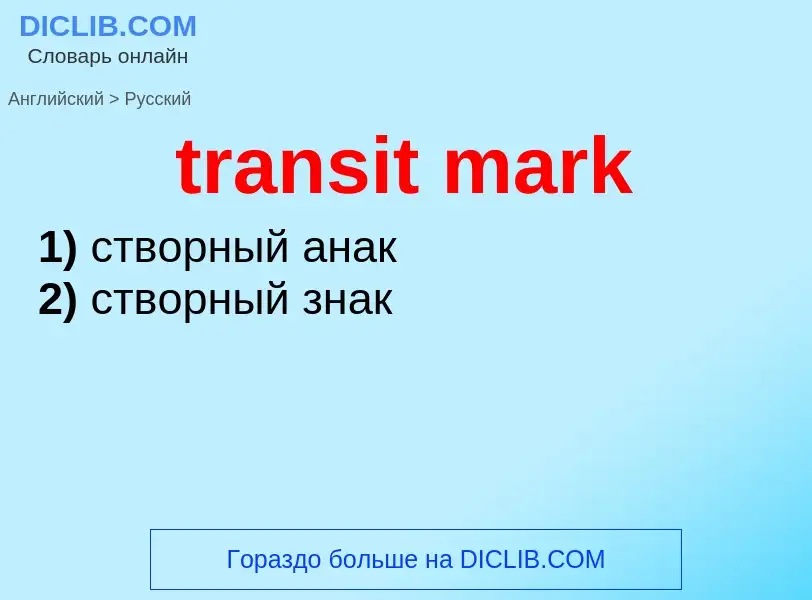Перевод и анализ слов искусственным интеллектом ChatGPT
На этой странице Вы можете получить подробный анализ слова или словосочетания, произведенный с помощью лучшей на сегодняшний день технологии искусственного интеллекта:
- как употребляется слово
- частота употребления
- используется оно чаще в устной или письменной речи
- варианты перевода слова
- примеры употребления (несколько фраз с переводом)
- этимология
transit mark - перевод на русский
[trænsitɔ:'θɔriti]
общая лексика
управление городского транспорта (Нью-Йорка)
['si:mɑ:k]
существительное
морской термин
навигационный знак
ориентировочный предмет
линия уровня полной воды (в море)
[siktrænsitglɔ:riə'mundi]
Латинский язык
так проходит слава земная
американизм
восклицательный знак
общая лексика
знак сертификации
['træn|sit-{'træn}zit]
общая лексика
кульминация
перекачка
переход
пролет
прохождение
створ
транзит
американизм
городской транспорт
строительное дело
тахеометр
теодолит
нефтегазовая промышленность
перекачивание (нефтепродуктов)
Смотрите также
прилагательное
['træn|sit-{'træn}zit]
общая лексика
транзитный
существительное
['træn|sit-{'træn}zit]
общая лексика
проезд
прохождение
распространение
перевозка
транзит
перемена
переход (в другое состояние)
теодолит
(навигационный) створ
транзит, перевозка
переход (в другое состояние)
транзитный
кратковременный
преходящий
американизм
(городской) транспорт
физика
пролёт (частиц)
астрономия
прохождение планеты (через меридиан)
кульминация
прохождение планеты через меридиан
глагол
общая лексика
переходить
переезжать
пропускать
переходить в иной мир
умирать
переходить, переезжать
переходить в иной мир, умирать
астрономия
проходить через меридиан
Определение
Википедия

Innovia Metro is an automated rapid transit system manufactured by Alstom. Innovia Metro systems run on conventional metal rails and pull power from a third rail but are powered by a linear induction motor that provides traction by using magnetic force to pull on a "fourth rail" (a flat aluminum slab) placed between the running rails. However, newer versions of the technology are available with standard electric rotary propulsion.
The design was originally developed in the 1970s by the Urban Transportation Development Corporation (UTDC), a Crown corporation owned by the government of Ontario, Canada. It was designed as a system that would provide economic rapid transit service in the suburbs, which would have ridership levels between what a bus could serve at the low-end, or a subway at the high-end. During development, the system was known as the ICTS (Intermediate Capacity Transit System). The ICTS was chosen for lines in Vancouver, Toronto, and Detroit. Further sales were not forthcoming and the Ontario government lost interest in the company, selling it to Lavalin of Quebec in 1986. Lavalin ran into serious financial difficulties and the UTDC returned to Ontario control, only to be immediately sold to Bombardier.
Bombardier used the name Advanced Rapid Transit (ART) after its acquisition of the technology. The company was much more active in developing and promoting this system, introducing a major new revision and winning several additional sales in New York City, Beijing, Kuala Lumpur and Yongin, near Seoul.
Bombardier would later be purchased by Alstom, which continues to market the technology. The latest version is marketed as the Innovia Metro, while previous models are retroactively branded as Innovia ART. The largest system is part of the Vancouver SkyTrain metro network, which has seen several major expansions over its lifetime. It operates just under 50 kilometres (31 mi) of track compatible with Innovia Metro trains. Vancouver was the first to order Innovia Metro 300 vehicles. Since then, vehicle orders for the latest Innovia Metro technology have been made by transit authorities in Kuala Lumpur and Riyadh.


![[[55 Broadway]], headquarters of [[Transport for London]] 1929-2020 [[55 Broadway]], headquarters of [[Transport for London]] 1929-2020](https://commons.wikimedia.org/wiki/Special:FilePath/55 Broadway - geograph.org.uk - 1142385.jpg?width=200)
![[[370 Jay Street]] headquarters of [[New York City Transit Authority]] 1951-2012 [[370 Jay Street]] headquarters of [[New York City Transit Authority]] 1951-2012](https://commons.wikimedia.org/wiki/Special:FilePath/Jay St Bklyn td 05 - 370 Jay Street.jpg?width=200)

![Red [[buoy]] in San Diego Harbor, with a light, number, and radar corner reflectors. Red [[buoy]] in San Diego Harbor, with a light, number, and radar corner reflectors.](https://commons.wikimedia.org/wiki/Special:FilePath/Buoy seal.jpg?width=200)
![Green can #11 near the mouth of the [[Saugatuck River]]. Green can #11 near the mouth of the [[Saugatuck River]].](https://commons.wikimedia.org/wiki/Special:FilePath/Canbuoy11.jpg?width=200)
![Same Green can #11, on a NOAA [[nautical chart]]. Same Green can #11, on a NOAA [[nautical chart]].](https://commons.wikimedia.org/wiki/Special:FilePath/Can 11 in Saugatuck river.jpg?width=200)
![Triangular [[daymark]] in the [[marina]] of [[Ystad]] 2021. Triangular [[daymark]] in the [[marina]] of [[Ystad]] 2021.](https://commons.wikimedia.org/wiki/Special:FilePath/Enslinje - Ystad-2021.jpg?width=200)

.png?width=200)
![periods]] would be used in the entire book. periods]] would be used in the entire book.](https://commons.wikimedia.org/wiki/Special:FilePath/Action252.jpg?width=200)
![Catalan]] (top line) and English Catalan]] (top line) and English](https://commons.wikimedia.org/wiki/Special:FilePath/Billboard at Montjuïc, Barcelona (detail).jpg?width=200)
![New Zealand road sign warning of a "cattle stop" ([[cattle grid]]/cattle guard) New Zealand road sign warning of a "cattle stop" ([[cattle grid]]/cattle guard)](https://commons.wikimedia.org/wiki/Special:FilePath/Cattle stop sign - New Zealand.jpg?width=200)



![Two TransIT buses ([[Orion V]] #065 and [[Gillig Low Floor]] #981) heading toward the square, downtown in the fall 2012. Two TransIT buses ([[Orion V]] #065 and [[Gillig Low Floor]] #981) heading toward the square, downtown in the fall 2012.](https://commons.wikimedia.org/wiki/Special:FilePath/Frederick transit 065 981.jpg?width=200)








![[[Regulatory Compliance Mark]] [[Regulatory Compliance Mark]]](https://commons.wikimedia.org/wiki/Special:FilePath/RCM Mark.png?width=200)
![asthma & allergy friendly]] asthma & allergy friendly]]](https://commons.wikimedia.org/wiki/Special:FilePath/Canada general-mark.jpg?width=200)
![EAC mark]] EAC mark]]](https://commons.wikimedia.org/wiki/Special:FilePath/EAC-black-on-white.gif?width=200)
![[[Norma Oficial Mexicana]] [[Norma Oficial Mexicana]]](https://commons.wikimedia.org/wiki/Special:FilePath/Norma Oficial Mexicana logo.png?width=200)
![[[ETL SEMKO]] [[ETL SEMKO]]](https://commons.wikimedia.org/wiki/Special:FilePath/SEMKO.png?width=200)
![[[Kitemark]] [[Kitemark]]](https://commons.wikimedia.org/wiki/Special:FilePath/Kitemark.png?width=200)
![[[NTA Inc]] [[NTA Inc]]](https://commons.wikimedia.org/wiki/Special:FilePath/NTA Mark.png?width=200)
